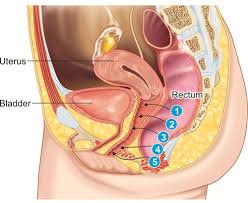What is Recto Vaginal Fistula?
A fistula is an abnormal connection between two organs. The rectovaginal fistula is the connection between a woman’s rectum and vagina. The opening allows stool and gas to leak from the bowel into the vagina.

Causes of Recto Vaginal Fistula
- Injuries during childbirth : Delivery-related injuries are the most common cause of rectovaginal fistulas. This includes tears in the perineum that extend to the bowel, or an infection of an episiotomy ( a surgical incision to enlarge the perineum during vaginal delivery). These may happen following a long, difficult or obstructed labor. These types of fistulas may also involve injury to anal sphincter.
- Inflammatory bowel disease (IBD) : Crohn’s disease and Ulcerative colitis are types of inflammatory bowel disease. They cause digestive tract lining is inflamed. Most women with Crohn’s disease rarely develop a rectovaginal fistula. But having IBS does increase your risk.
- Cancer or radiation treatment in your pelvic area : Cancerous growth in rectum, cervix, vagina, uterus or anal canal can result in a rectovaginal fistula. Radiation therapy for cancer in these areas can trigger fistula within six months to two years after treatment.
- Surgery involving your vagina, perineum, rectum or anus : Any surgery in lower pelvic region can be the case of development of RV fistula. This may be as a result of an injury during surgery or a leak or infection that develops afterward.
- Other causes : Rarely, a rectovaginal fistula may be caused by infections in anus or rectum, infected pouches in intestines (diverticulitis), infections due to HIV, sexual assault.
Symptoms of RVF
- Passage of gas, stool or pus from vagina
- Foul-smelling vaginal discharge
- Repeated vaginal infections
- Pain and irritation in the vagina or the area between vagina and anus
- Pain during sexual intercourse
- Trouble controlling bowel movements
How is RVF diagnosed?
- Physical Examination :
Doctor will examine vagina, anus and the area between them to locate fistula and its opening. Low level rectovaginal fistula is clearly visible ( see no 3 & 4 in above picture). Also doctor may ask history of pregnancy, any disease and sexual relationship, etc. If fistula is not visible due to deep location, doctor may need further tests to confirm the structure –
- USG
- MRI / CT scan
- Other tests related to particular disease like IBS, HIV, TB, etc.
Treatment of Recto vaginal fistula
Antibiotics can be used only to control the infection. There are only two treatments available – Surgery and Kshar sutra treatment.
Ayurvedic Kshar sutra treatment for RVF
Ayurvedic Kshar sutra treatment can cure RVF only in 4th and 5th position (not too deep) as shown in the picture.
In our clinic, in India we treat RVF Kshar sutra treatment
We have developed different probing techniques for each type of fistula. Using appropriate technique, kshar sutra is inserted correctly in the fistula tract. The success of the treatment depend on two things – quality of kshar sutra & its correct insertion in the fistula track. We take care of both. This herbal thread is changed after every 7 days. Duration of treatment is 4 to 6 weeks. The duration & cost of the treatment depend on the length & stage of fistula. No recurrence , no daily dressing required , no hospitalization required , no bed rest and can resume his / her routine work within few hours .

Surgery for Recto vaginal fistula
Warning :
The information given is short description of surgical treatment practiced all over the world. We don’t follow this practice. We do only Kshar sutra treatment in our clinic.
Surgery to close a fistula may be done by a gynecologic surgeon, a colorectal surgeon or both working as a team. The goal is to remove the fistula tract and close the opening by sewing together healthy tissue. Surgical options include:
- Sewing an anal fistula plug or patch of biologic tissue into the fistula to allow your tissue to grow into the patch and heal the fistula.
- Using a tissue graft taken from a nearby part of your body or folding a flap of healthy tissue over the fistula opening.
- Repairing the anal sphincter muscles if they’ve been damaged by the fistula or by scarring or tissue damage from radiation or Crohn’s disease.
- Performing a colostomy before repairing a fistula in complex or recurrent cases to divert stool through an opening in your abdomen instead of through your rectum. Most of the time, this surgery isn’t needed. But you may need this if you’ve had tissue damage or scarring from previous surgery or radiation treatment, an ongoing infection or significant fecal contamination, a cancerous tumor, or an abscess. If a colostomy is needed, your surgeon may wait eight to 12 weeks before repairing the fistula. Usually after about three to six months and confirmation that your fistula has healed, the colostomy can be reversed and normal bowel function restored.
Diet and routine activities during Kshar sutra treatment
From the day of Kshar sutra threading procedure, light diet is advised. Patient is also advised to take plenty of fluids, blend diet, green vegetables, salad and seasonal fruits. Avoid non-vegetarian, spicy and fermented food. Do not strain during defecation. Sitting in warm water is useful for cleaning & pain relief. Take a walk at least 2 kilometers per day.